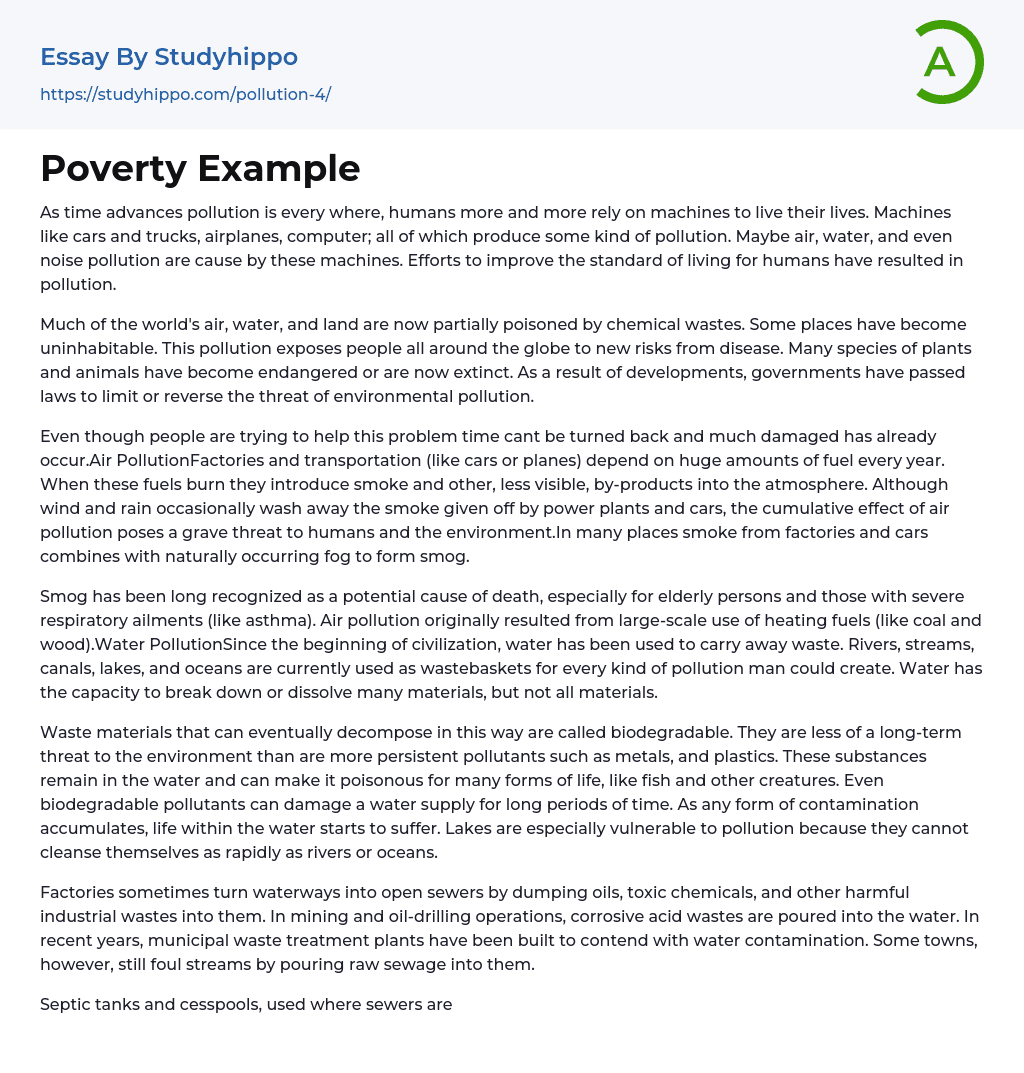Pollution is increasingly common as machines like cars, trucks, airplanes, and computers contribute to various forms of pollution such as air, water, or noise pollution. Unfortunately, efforts to improve human living standards have resulted in pollution that has contaminated a large portion of the world's air, water, and land with chemical waste. This contamination has made certain areas uninhabitable and exposed people worldwide to new disease risks. Furthermore, pollution has caused numerous plant and animal species to become endangered or extinct. Governments have implemented laws to mitigate these environmental threats; however, irreversible damage has already occurred.
Air pollution is one type of pollution that occurs when factories and transportation burn substantial amounts of fuel annually. This combustion releases smoke and other by-products into the atmosphere. Although wind and r
...ain occasionally temporarily clear this smoke emitted by power plants and cars overall air pollution poses significant dangers for both humans and the environment. The combination of factory and vehicle smoke with natural fog creates smog in many areas. Smog has long been recognized as a potential cause of death for elderly individuals and those with respiratory conditions like asthma.
Initially, air pollution was caused by the widespread use of coal and wood for heating. Throughout history, water pollution has been caused by waste disposal into water sources. Nowadays, various types of human-made pollution are still being dumped into rivers, streams, canals, lakes, and oceans. While water can dissolve or break down many materials, it cannot decompose all substances. Waste materials that eventually decompose are called biodegradable pollutants and are less harmful to the environment compared to persistent pollutants like metals and plastics. These persisten
substances remain in the water and make it toxic for aquatic life such as fish. Even biodegradable pollutants have the potential to harm water supplies for extended periods of time. As contamination accumulates, aquatic life in the water begins to suffer. Lakes are particularly vulnerable to pollution because they cannot cleanse themselves as quickly as rivers or oceans do. Factories sometimes turn bodies of water into open sewers by disposing oils, toxic chemicals, and other harmful industrial wastes into them. Mining and oil-drilling operations release corrosive acid wastes into the water. Municipal waste treatment plants have been established to address concerns about water contamination; however, some towns still directly pour untreated sewage into streams, contaminating themIn areas without sewer systems, septic tanks and cesspools can contaminate groundwater and streams with disease-causing organisms. Even when sewage is treated in purification plants, it can still contribute to water pollution if high levels of nitrogen and phosphorus are present. These chemicals are used in the purification process itself. In regions where farm fertilizers are applied, nitrate levels in groundwater increase, making it unfit for consumption. Additionally, agricultural runoff introduces dangerous pesticides as well as oil, dirt, and ice-melting chemicals from city streets into waterways.
Cities also face issues with noise pollution caused by various sources such as car and truck noises within urban areas. The intensity or volume of sound is measured in decibels (dB), with a clap of thunder typically reaching around 100 dB. Sounds at or above 120 dB cause distress and have the potential to damage ears. Noise pollution is prevalent in cities due to the combination of traffic and construction sounds that echo between tall
buildings. This continuous disruptive noise has become an unpleasant reality for urban residents.
Furthermore, certain genres of music—particularly heavy metal rock music played at excessively high volumes—have led to hearing loss among musicians and their audiences.According to research, loud noises can have detrimental effects on both human health and work performance. Excessive noise levels such as loud music or honking car horns can impair brain function and interfere with concentration.
- Environment Pollution essays
- Plastic Pollution essays
- Overpopulation essays
- Homelessness essays
- Hunger essays
- Dumpster Diving essays
- Homelessness In America essays
- Bottled Water essays
- Air Pollution essays
- Carbon Dioxide essays
- Climate essays
- Deforestation essays
- Ecology essays
- Endangered Species essays
- Environmental Issues essays
- Environmental Protection essays
- flood essays
- Greenhouse Gas essays
- Hurricane essays
- Nature essays
- Pollution essays
- Renewable Energy essays
- Sustainability essays
- Tornado essays
- Traffic essays
- Tsunami essays
- Water Pollution essays
- Abortion essays
- Abuse essays
- Animal Rights essays
- Animal Testing essays
- Assault essays
- Bullying essays
- Controversial Issue essays
- Crash essays
- Cyber Bullying essays
- Feminism essays
- Human Rights essays
- Immigration essays
- Inequality essays
- Poverty essays
- Prejudice essays
- Racism essays
- Torture essays
- Violence essays
- Atmosphere essays
- Biodiversity essays
- Coral Reef essays
- Desert essays
- Earth essays




